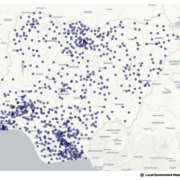Open Banking is gaining grounds worldwide and the Central Bank of Nigeria (CBN) has expectedly responded to the trends by issuing the Regulatory Framework for Open Banking in Nigeria earlier this year. The framework establishes principles for data sharing across the banking and payments ecosystem, which will promote innovation, broaden the range of financial products and services, and deepen financial inclusion.
The regulatory framework stipulates data and Application Programming Interface (API) access requirements, principles for API, data, technical design and information security specifications among others.
WhiteSight partners Spire Tech on global study of Open Banking
WhiteSight has partnered with Spire Tech – an Aion Digital Company, to launch a global study of Open Banking ecosystem initiatives and take a predictive shot at the future course of the financial services industry transformation – enabled by the collaboration between incumbents, insurgents, enablers, and new entrants.
The Spire Tech and WhiteSight Open Banking Report 2021 is now live and free to download. Check it out here.
While several incumbent banks across the globe have launched greenfield/brownfield digital banks, as a part of their digital transformation agendas to deal with the digital disruption; we feel the real impetus may come from leveraging the potential platformification opportunities that Open Banking presents.
“The competition is not only between companies, it is between business ecosystems.” — Philip Kotler
Open Banking by design has put strong market incentives and regulatory nudges for banks to become modular, to focus on economies of scope and to consider creating business ecosystems as a part of their future strategy.
Open Banking evolution seems to have tentacles that span from basic use-cases which are enabled by mere provisioning of banking data through APIs, to sci-fi use-cases which will require a much larger strategic alignment between banks, fintechs, and non-bank partners in terms of their business models, cultures and of course technology architectures.
We formulated an evolution framework to peek into the Open Banking crystal ball and analyze potential evolution trajectories, that will require Openness of different categories and at different levels, to come to fruition. Incidentally, during our research, we were pleasantly surprised to find that these Openness Categories and levels are already in practice by financial and non-financial institutions, albeit with different levels of adoption and acceptance.
Open Banking: Data as the Bedrock of Digital Evolution
The Os of Open Banking:
- Open APIs: APIs can be termed as Open APIs when they follow established and accepted technical and functional standards to offer interoperability benefits to the participants.
- Open Payments: Open Payments enable consumers and third parties to initiate payment disbursements and/or collections. It enables digital payments to leapfrog the dependency of using intermediaries such as cheques, cards etc. to transact while ensuring security and customer consent requirements.
- Open Accounts Information: Open Accounts Information enables customers to get an aggregated view of their account information including all debits and credits that have happened over a period of time. This aggregated view unearths behavioural insights that can help consumers improve their financial decisions and activities. The insights can also help financial institutions improve their customer engagement and product development initiatives.
Open Finance: The Innovation Intersection
The Os of Open Finance:
- Open Products: Open products are the building blocks of financial marketplaces where a bank can augment and supplement its current offerings by including products – both financial and non-financial from partners to provide choice and personalization to customers.
- Open Processes: Business processes in banking can be significantly improved by enabling data and capabilities sharing between a bank and digital enterprises. Business processes for a lending decision can be improved by sharing alternate data for creditworthiness assessment whereas post-disbursement monitoring can be improved by monitoring the loan amount utilization and business volumes of the borrower.
- Open Innovation: Open innovation is a term used to promote a digital age mindset toward innovation that runs counter to the secrecy and silo mentality of traditional corporate research labs. Banks may create a collaborative innovation culture with startups by offering them support in terms of infrastructure, operational data, beta launch, etc.
- Open Assets: In the digital world, the way banks can create and share digital assets will define the future of banking as it will enable banks to embed themselves in emerging themes without taking the undue risks of operationalizing the entire innovation lifecycle. Banking as a Service, Payments as a Service, Compliance as a service, etc. are some of the routes that are enabling banks to unlock their assets for collaborative value creation.
Open Economy: Every Company will be a FinTech Company
The Os of Open Economy:
- Open Data: While opening up Banking data, enables a significant amount of customer-centric innovation, the buck doesn’t and shouldn’t stop with banks. In the digital realm, data residing with e-commerce firms, payroll providers, health institutions, utility companies, etc. can bring significant complementarity to the banking data to power next-generation financial services.
- Open Business Models: With the emergence of Platform business models, enterprises are increasingly creating, promoting, and participating in business ecosystems. This requires the business models themselves to be based on a ‘Shared-risk and Shared-reward’ mentality and ensure transparency and trust between the platform ecosystem participants.
- Open Talent: The future of work is undergoing significant changes in the pandemic-imposed remote work environment. However, this can unlock advantages for enterprises as they can now create virtual teams across the globe and also take advantage of Gig-economy specialists for specific skill requirements.
- Open Experience: The holy grail of all these O’s of Open Banking, Open Finance, and Open Economy is to create superior experiences for customers which are hyper-personalized, Contextual, predictive, and pre-emptive. Open experiences in the world of ‘Open Economy’ can truly redefine the way firms and customers engage with each other for mutual gains.
IMAGE: Global Banking & Finance Review





























